Adlerangriff
Messerschmitt Bf 109 E
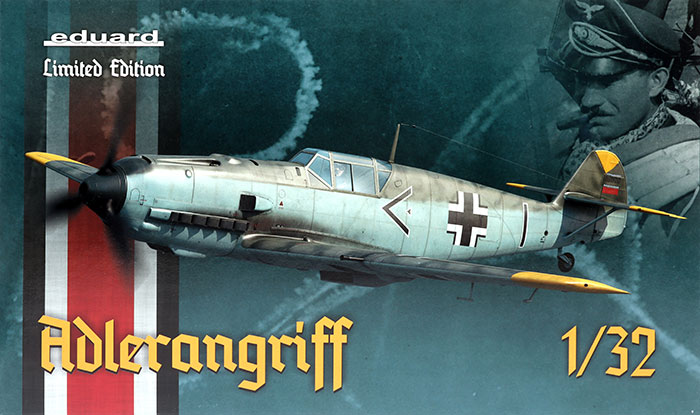
Eduard Limited Edition, 1/32 scale
S
u m m a r y : |
Description and Item No.: |
Eduard Limited Edition Kit No. 11107 - Adlerangriff |
Contents and Media: |
172 parts in grey coloured plastic, 12 parts in clear, two photo-etched frets (one in colour), canopy masks, four parts in grey resin, one part in white resin, a resin figure (made up from nine more grey resin pieces) markings for 13 aircraft plus full stencil data. |
Price: |
USD$89.95 plus shipping available online from Eduard's web store
GBP£46.17 EU Price (£38.48 Export Price) Plus Shipping at Hannants |
Scale: |
1/32 |
Review Type: |
First Look |
Advantages: |
High level of detail including optional engine; restrained and impressive surface features; separate control surfaces including flaps and leading edge slats; colour photo-etched parts; 13 colourful decal options. |
Disadvantages: |
Slats are slightly too deep; a few sink marks. |
Recommendation: |
The Adlerangriff boxing adds useful resin and 13 colourful marking options to their high quality, well detailed 1/32 scale Messerschmitt Bf 109 E that is quite straightforward to build and looks great when finished. |
Reviewed by Brett Green

The Messerschmitt Bf 109 E
The Messerschmitt Bf 109 A, B, C and D were powered by the Junkers Jumo engine. The Spanish Civil War presented the opportunity to test these revolutionary fighters in action, and they proved their worth in combat with Legion Condor over the skies of Spain.
The Messerschmitt Bf 109 E series was the first of the family to be fitted with the Daimler Benz DB601A engine, resulting in a significant improvement in performance.
Two variants were manufactured in parallel - the lightweight Bf 109 E-1 which retained the wing-mounted 7.9mm machine guns of the earlier Bf 109 B, C and D; and the Bf 109 E-3 which was fitted with one 20mm MG FF cannon in each wing. Both variants featured two additional 7.92mm machine guns in the cowl.
The Messerschmitt Bf 109 E-4 shared the armament of the E-3 but introduced a number of improvements, including a revised canopy.

The Messerschmitt Bf 109 E-4 fought alongside the Bf 109 E-1 and E-3 in the invasion of France and the Low Countries and the Battle of Britain in addition to later campaigns in the Balkans, North Africa and the Soviet Union.
Operation Adlerangriff
Unternehmen Adlerangriff ("Operation Eagle Attack") was the codename of a military operation by the Luftwaffe to destroy the British Royal Air Force.
By June 1940, the Allies had been defeated in Western Europe and Scandinavia. Rather than come to terms with Germany, Britain rejected all overtures for a negotiated peace. \
During the Battle of Britain, Hitler gave the German armed forces a directive that ordered provisional preparations for invasion of Britain. This operation was codenamed Operation Sea Lion.
Before this could be carried out, air superiority or air supremacy was required. The Luftwaffe was to destroy the RAF in order to prevent it from attacking the invasion fleet or providing protection for the Royal Navy's Home Fleet, which might attempt to prevent a landing by sea.
On 1 August Hitler gave the Luftwaffe's commander-in-chief, Reichsmarschall Hermann Göring and the Oberkommando der Luftwaffe a directive to launch the air assault. The essential target was RAF Fighter Command. The service's destruction would deny the British their air superiority asset.
Throughout July and early August, the Germans made preparations for Adlertag - the first day of Adlerangriff. The date of the assault was postponed several times because of bad weather. Eventually, it was carried out on 13 August 1940.
The German attacks on 13 August inflicted significant damage and casualties on the ground, but, marred by poor intelligence and communication, they did not make a significant impression on Fighter Command's ability to defend British air space.
Göring had promised Hitler that Adlertag and Adlerangriff would achieve the results required within days, or at worst weeks. It had meant to be the beginning of the end of RAF Fighter Command, but Adlertag and the following operations failed to destroy the RAF, or gain the necessary local air superiority. As a result, Operation Sea Lion was postponed indefinitely.
Adapted from Wikipedia.
Eduard released their 1/32 scale Messerschmitt Bf 109 E-1 in February 2009. This kit was well detailed and included an engine that could be displayed, nicely detailed cockpit and subtle surface features.
I built the Eduard 1/32 scale Bf 109 E-1 kit back in March 2009. You can find a Construction Feature on this model by following this link.
Eduard also subsequently released 1/32 scale Bf 109 E-3, E-4 and E-7 kits with different wing and canopy parts.
Let's take a look at this latest boxing of Eduard's Bf 109 E..
What's New
Eduard's 1/32 scale Messerschmitt Bf 109 Adlerangriff boxing comprises 172 parts in grey coloured plastic, 12 parts in clear, two photo-etched frets (one in colour), canopy masks, four parts in grey resin, one part in white resin, a resin figure (made up from nine more grey resin pieces) markings for 13 aircraft plus full stencil data.
The biggest differences between the earlier releases and this Adlerangriff boxing are the inclusion of both early and late sprues for the wings and the canopy parts; plus the inclusion of resin main wheels, tail wheel, tail wheel well and the Adolf Galland figure.
I like the medium grey coloured plastic more than the original shade of tan. I know it sounds ridiculous, but for me at least there is a psychological factor that equates quality with the colour of the plastic. I know that this is not true, but I do prefer this medium grey colour!
The early wings feature machine gun armament only and no bulge on the lower wing. This is applicable to the Bf 109 E-1 and E-3.

The later-style wing is fitted with 20mm MG/FF machine guns. This configuration is typical of the Bf 109 E-4 and E-7.
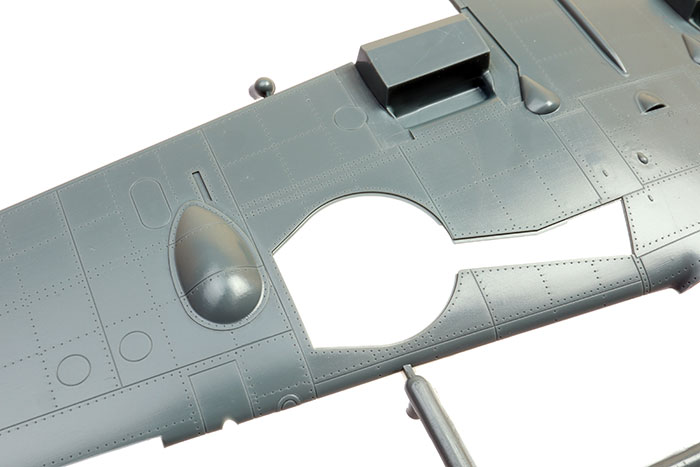
The resin wheels are a great improvement over the kit's plastic parts. The spoke detail on the tail wheel is just gorgeous too. In addition to the wheels, Eduard has also supplied a resin tail wheel well and strut. The strut is cast in strong, cream coloured resin.
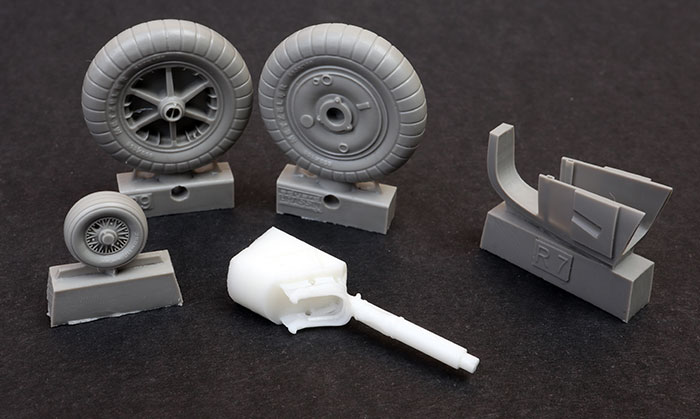
The colour photo-etched parts are the latest Eduard style with glossy dials and half-tone printed harness straps. These will really spice up the cockpit.
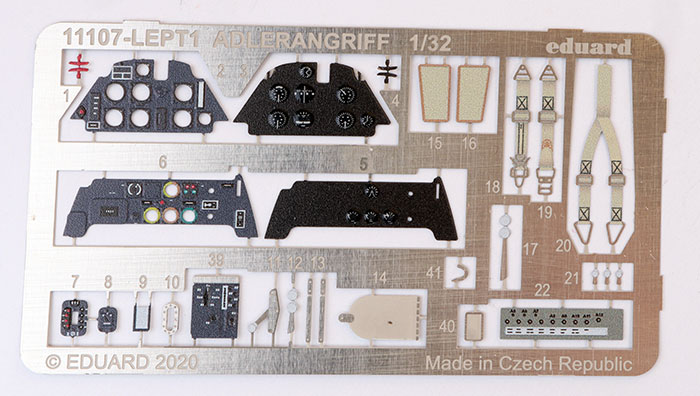
The second photo-etched fret is brass, and supplies other details such as trim wheel chains, rudder pedals, radiator faces and small details.
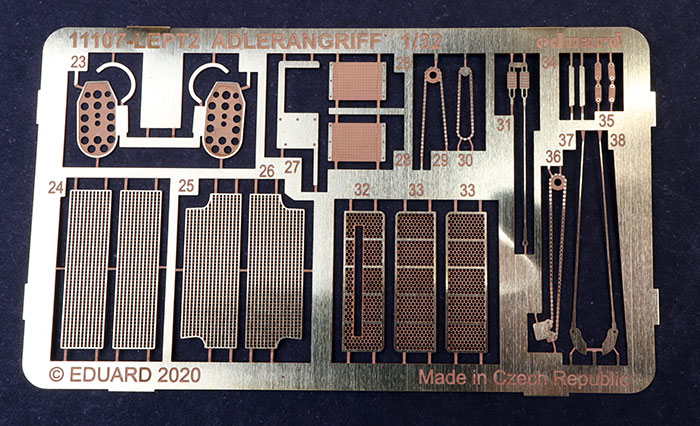
The early clear sprue contains five parts for the Bf 109 E-1 and E-3.
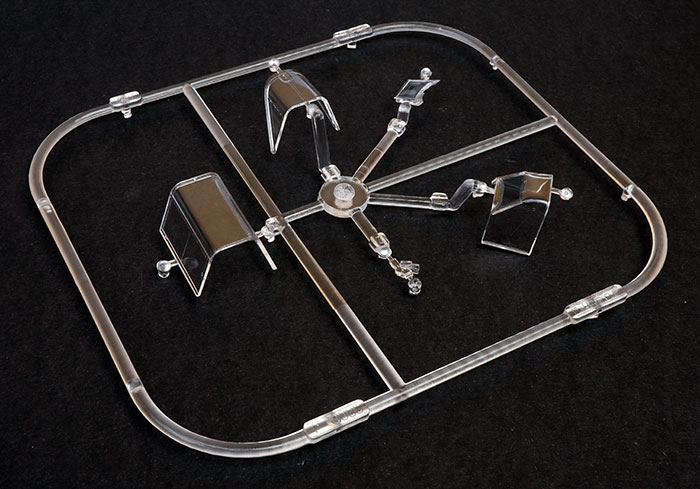
The late version clear sprue has seven parts.

These include an optional windscreen with an opening for Galland's famous telescopic sight.
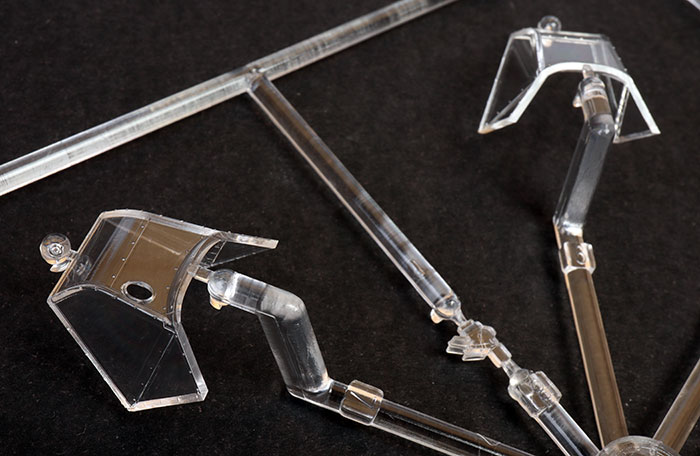
The inclusion of a pilot figure is a nice touch.
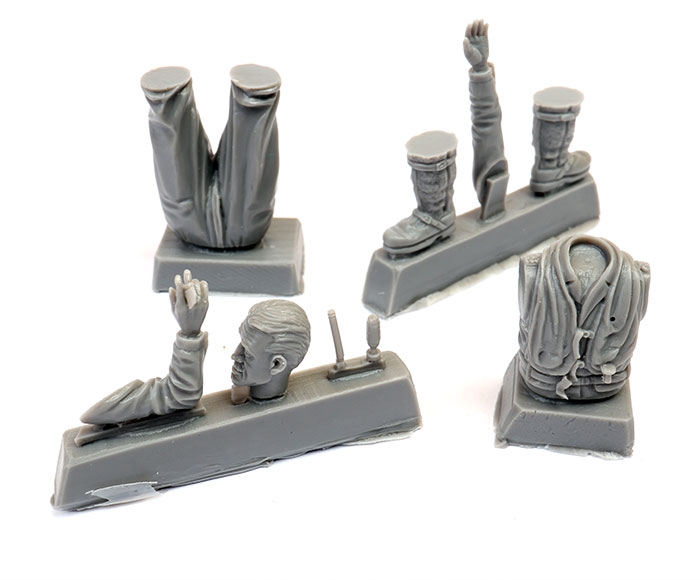
The figure is broken down into nine perfectly cast resin parts. With the facial detail and cigar this is unmistakably Adolf Galland.
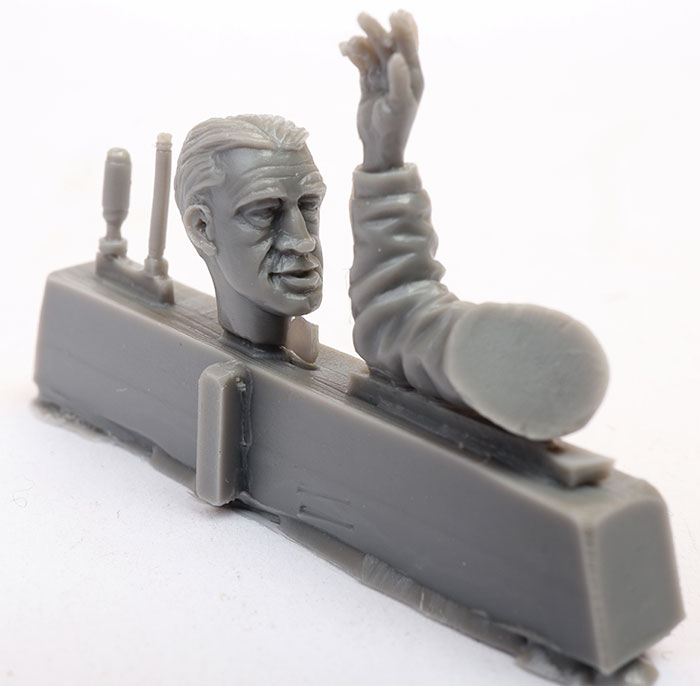
Decals have been printed by Eduard.
Three decal sheets are included. These cover Battle of Britain era Bf 109 E-1, E-3 and E-4 subjects.

One large sheet contains the national markings, the next includes the main aircraft markings and the smaller third sheet supplies a full set of stencils.

A number of alternatives are included on the stencil sheet.
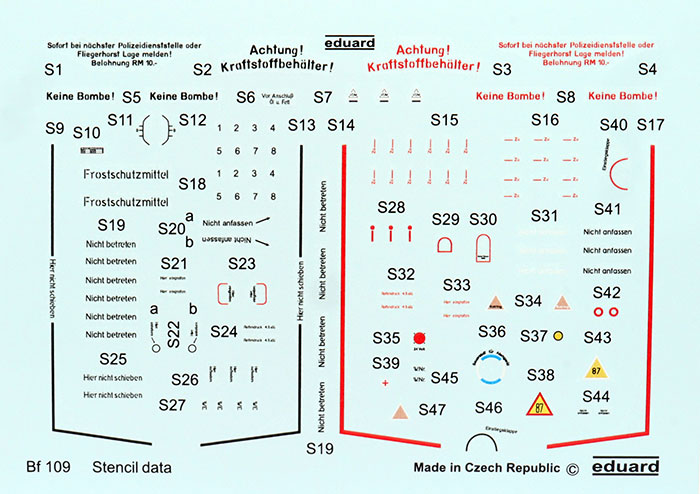
A whopping 13 marking options are offered, with plenty of variety in camouflage and markings.
The Eduard 1/32 Bf 109 E in Detail
With the specifics of the Adlerangriff contents covered, let's take a look at the Bf 109 E in general.
Plastic parts are very well moulded, with only a few shallow sink marks that will be visible on the finished model (most notably the front of the top wing halves near the wing roots).
Surface detail is state-of-the-art. Finely recessed panel lines are supplemented with even finer rows of rivets. These are barely visible at some angles, and are consistent over the whole airframe. Very nice indeed. Control surfaces feature raised "fabric strips" and stitching. Lighting for photography seems to exaggerate the effect, but they look great on the sprues. Even so, if the fabric sag is too much for your personal taste, it will be a simple matter to fill the recesses with Mr Surfacer, or lightly sand the raised ribs.
Detail is excellent. The plastic cockpit parts are combined with colour and nickel-plated photo-etch to deliver an authentic front office.
A full engine is supplied, but this is an optional element. The DB601A engine may be installed and displayed, or the cowl may be glued closed without the engine. Alternate parts are supplied to mount the propeller, the exhaust stubs and the cowl guns if the second option is chosen.
The engine looks good. Individual exhaust stubs are provided. These are hollow at the end and have raised weld seams down the middle - don't sand these off!
The engine cowking is supplied in four pieces - the main upper cowl, two rear side cowl panels and the gun deck.
All control surfaces are separate - the flaps, leading edge slats, ailerons, elevators and rudder. The rudder actuator is provided in photo-etched metal. Flaps are moulded with tabs that will pose them dropped without modification, but it will be very easy to slice off the tabs and reposition if desired.
The oil cooler and wing radiator front and rear faces are all supplied as photo-etched grilles.
The main wheel wells are nice done. The ceiling of the well features a ring of raised rivets and reinforcement strips. The sides of the main wells are boxed in with separate parts.
The self-adhesive canopy masks are a time-saving touch.
Eduard's 1/32 scale Adlerangriff boxing adds some really useful resin plus the flexibility to build any of the major Bf 109 E variants straight from the one box.
In 2020, Eduard's 1/32 scale Messerschmitt Bf 109 E remains very well detailed straight from the box, and the modeller has the choice of tackling the engine or simply buttoning up the cowl.
Construction should be as straightforward as my Bf 109 E-1 back in 2009.
This is a welcome and good quality package from Eduard.
Thanks to Eduard for the sample.
Review Text and Images Copyright © 2020 by Brett Green
Page Created 14 October, 2020
Last updated
15 October, 2020
Back to HyperScale Main Page
Back to Reviews Page
|
Home
| What's New |
Features |
Gallery |
Reviews |
Reference |
Forum |
Search